施用石灰和植树后金属污染对凋落物分解和土壤呼吸的最小遗留影响
IF 8
1区 环境科学与生态学
Q1 ENVIRONMENTAL SCIENCES
引用次数: 0
摘要
金属污染阻碍土壤呼吸和凋落物分解等生态系统过程。包括石灰和植树在内的森林修复工作不能去除金属,但可以改变土壤的化学性质,如pH值和有机物含量,从而减轻金属压力。在这项研究中,我们评估了安大略省大萨德伯里市11个地点的土壤呼吸和凋落物分解率,这些地点的金属(铜(Cu)和镍(Ni))污染程度不同,并且已经进行了近50年的绿化处理(石灰、施肥和植树)。与40年前在该地区未经处理的地点进行的研究相比,我们没有发现土壤金属污染与森林地面质量或分解率之间的关系。不同地点间土壤呼吸的差异很大程度上归因于土壤温度的巨大差异,暴露较多、树木密度较低的温暖地点土壤呼吸率最高。土壤金属与土壤呼吸没有关系。然而,当土壤呼吸速率随温度归一化时,表层矿质土壤中水可萃取铜浓度较高的地点土壤呼吸速率较低。这些数据表明,在恢复生态系统功能方面,绿化工作在很大程度上是成功的,尽管遗留金属污染对土壤呼吸有一定影响,但这种影响在很大程度上被土壤温度的大微点变化所抵消。本文章由计算机程序翻译,如有差异,请以英文原文为准。

Minimal legacy effects of metal pollution on litter decomposition and soil respiration following liming and tree planting
Metal contamination impedes ecosystem processes such as soil respiration and litter decomposition. Forest remediation efforts that include liming and tree planting do not remove metals but alter soil chemical properties like pH and organic matter content that may alleviate metal stress. In this study we evaluated soil respiration and litter decomposition rates at 11 sites in the City of Greater Sudbury, Ontario that vary in metal (copper (Cu) and nickel (Ni)) contamination and have undergone regreening treatment (liming, fertilizing, and tree planting) that has been ongoing for almost 50 years. In contrast to studies in the region conducted 40 years ago on untreated sites we found no relationship between soil metal contamination and forest floor mass or decomposition rates. Differences in soil respiration among sites were largely attributable to large differences in soil temperature, with more exposed warmer sites with lower tree density having the highest rates of soil respiration. There were no relationships between soil metals and soil respiration. However, when soil respiration rates were normalized for temperature, sites that had higher water-extractable Cu concentrations in surface mineral soils had lower soil respiration rates. These data show that regreening efforts have largely been successful in restoring ecosystem function and while legacy metal pollution has some effect on soil respiration this effect is largely outweighed by large microsite variation in soil temperature.
求助全文
通过发布文献求助,成功后即可免费获取论文全文。
去求助
来源期刊

Science of the Total Environment
环境科学-环境科学
CiteScore
17.60
自引率
10.20%
发文量
8726
审稿时长
2.4 months
期刊介绍:
The Science of the Total Environment is an international journal dedicated to scientific research on the environment and its interaction with humanity. It covers a wide range of disciplines and seeks to publish innovative, hypothesis-driven, and impactful research that explores the entire environment, including the atmosphere, lithosphere, hydrosphere, biosphere, and anthroposphere.
The journal's updated Aims & Scope emphasizes the importance of interdisciplinary environmental research with broad impact. Priority is given to studies that advance fundamental understanding and explore the interconnectedness of multiple environmental spheres. Field studies are preferred, while laboratory experiments must demonstrate significant methodological advancements or mechanistic insights with direct relevance to the environment.
 求助内容:
求助内容: 应助结果提醒方式:
应助结果提醒方式:


